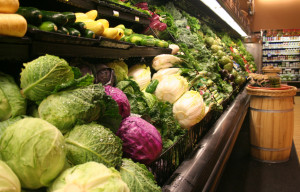 If you run a grocery store, you probably mist your produce with purified water to extend its shelf life by 24 to 48 hours. What you might not realize is that in many cases, this “purified” water may have high counts of bacteria, posing a threat to your customers’ health.
If you run a grocery store, you probably mist your produce with purified water to extend its shelf life by 24 to 48 hours. What you might not realize is that in many cases, this “purified” water may have high counts of bacteria, posing a threat to your customers’ health.
We realize how important it is for grocery stores to use purified water – as opposed to standard soft or hard water – for a myriad of applications, including misting. Not only does it reduce white calcium build-up and spotting on vegetables, it also prevents issues in other applications, like coffee equipment, steamers and proofers.
However, unbeknownst to many grocery store owners, their water could have high bacteria counts. To fully understand the issue, we’ll have to start with a brief history lesson.
How it Started: Purified Drinking Water in Grocery Stores
Years ago, grocery stores began hosting drinking water dispensers for customers to self-fill and purchase RO (reverse osmosis) drinking water. The dispensers included water treatment equipment, such as carbon filters, reverse osmosis units and ultraviolet disinfection (UV) equipment. This design is very similar to a residential drinking water system that you would find underneath your sink at home.
The potential issues were created when grocery stores realized they could use this same water to mist produce, as well as for their steamers, bread proofers and coffee equipment.
The problem isn’t really the water, but the design of the system that carries the water. The water treatment vendors who provide the majority of these systems have never changed their design to help control bacteria in the systems.
Excessively Long Pipes Leading to Bacteria Growth
In the water dispensers we previously described, the water treatment equipment is generally installed within two feet of where the water is dispensed.
This set-up is actually similar to most residential drinking water systems, and is perfectly safe as long as the proper maintenance is completed and the system is disinfected on an annual basis.
This isn’t the case, however, for most other grocery store water applications. Distributing water to misters and other points of use normally requires hundreds of feet of clear plastic tubing, which wind throughout the facility. We refer to this configuration as a “dead-leg” system.
We don’t use this morbid sounding name just for kicks. When the water isn’t actively used, such as during off-hours or at night, the water sits stagnant in the pipes.
If there’s one thing bacteria loves, it’s stagnant water. Compounding this problem is the fact the vast majority of these piping systems are NEVER disinfected.
When this water is misted onto vegetables, it’s no longer that same bacteria-free water from which it originated. That means there’s a greater chance the water will pass an infectious pathogen through the air, like legionella.
At this point, a coliform test alone won’t tell the whole story. A Total Plate Count (TPC) and/or legionella test is required to reveal all bacterial growth in the water.
“But My Tests Don’t Reveal any Bacteria”
When we approach grocery stores about this issue, we often hear the same thing: “I’ve tested my water or my supplier has tested my water, and it’s bacteria and coliform free.”
This response is a big red flag that a person isn’t actually testing for TPC. If the grocery store was truly testing for TPC and legionella, they’d find at least some bacteria in the water, even if it’s innocuous.
This water is a ticking time bomb for harmful bacterial contamination. That’s why we’ve worked with dozens of grocery stores to install properly designed systems, engineered to control bacteria 24/7.
We’ve tested our systems for TPC and legionella, and they’ve passed with flying colors, every time (they’ve also been verified by Phigenics, a third party legionella validation service).
Be warned, grocery store owners. Without the proper water treatment systems in place, your water could grow harmful bacteria and pathogens, placing your customers at risk.
We’ll do more than give you a quote—we’ll visit your site to analyze your industrial water needs.

Follow Us